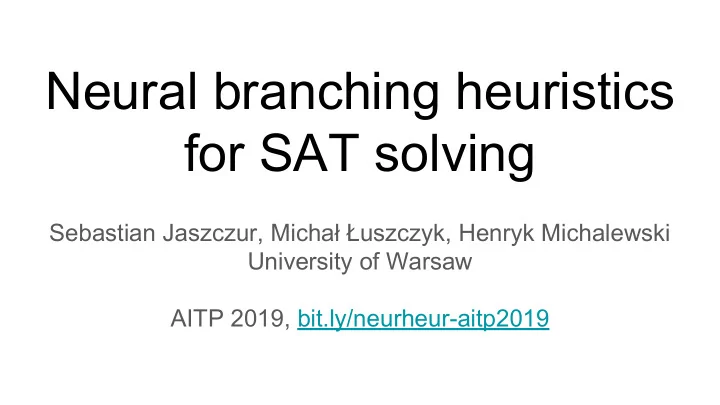

Neural branching heuristics for SAT solving Sebastian Jaszczur, Michał Łuszczyk, Henryk Michalewski University of Warsaw AITP 2019, bit.ly/neurheur-aitp2019
Overview 1. Introduction 2. The neural network 3. Experiments 4. Conclusions bit.ly/neurheur-aitp2019 2
1. Introduction. DPLL algorithm DPLL – basic backtracking algorithm for SAT solving. For illustration purposes. Our work applies to CDCL, too! bit.ly/neurheur-aitp2019 3
2. Models bit.ly/neurheur-aitp2019 4
Neural network interface satisfiable? 1 CNF formula Neural (A v ¬C) ^ (¬B v C) ^ (B v C) Network A B C 0 1 0 1 1 1 ¬A ¬B ¬C policy bit.ly/neurheur-aitp2019 5
CNF invariants Invariant TreeNN, BOW Graph NN LSTM averaging “Variable renaming” - invariance No No Yes “Permutation of literals in clause” - invariance No Yes Yes “Permutation of clauses in formula” - invariance No Yes Yes “Negation of all occurrences of variable” - invariance No No Yes bit.ly/neurheur-aitp2019 6
CNF formula: graph representation We can erase the labels and have an equisatisfiable problem! bit.ly/neurheur-aitp2019 7
Graph neural network for CNF clauses Inspired by NeuroSAT Each vertex stores an embedding. In each iteration, each vertex: 1. calculates a message and sends to neighbours, 2. receives the messages and aggregates, 3. calculates its new embedding based on aggregate and previous embedding. bit.ly/neurheur-aitp2019 8
Attention mechanism in aggregation Aggregated message NeuroSAT: sum, our model: attention with sigmoid Multiply MLP V vectors Sender Senders Sender Message MLP Sender weights K vectors Sender Sigmoid Message MLP Receiver Q vector Sender logit-weights Dot product bit.ly/neurheur-aitp2019 9
Dataset SR ( x ) ● x - number of variables ● CNF distribution introduced in NeuroSAT ● formulas difficult for SAT solvers ● labels: generated with Glucose Problem difficulty: Average Average Average number of clauses formula size time for MiniSAT SR(30): 300 ± 33 1480±175 0.007 SR(110) 1060±50 5100±287 0.137 SR(150) 1450±60 6930±320 3.406 bit.ly/neurheur-aitp2019 10
2. Trained models. We trained 3-5 models on each of the following datasets. Mean and stdev over 3-5 trained models. bit.ly/neurheur-aitp2019 11
3. Experiments bit.ly/neurheur-aitp2019 12
Performance with DPLL compared to static heuristics; at step limit 1000 Learned heuristic better than DLIS. JW-OS better at SR(50)-SR(70) and worse at SR(90)-SR(110). bit.ly/neurheur-aitp2019 13
Hybrid vs JW-OS guiding DPLL and CDCL Hybrid - use Model SR(50) if sat probability > 0.3, otherwise fallbacks to JW-OS. Why? 1. Faster 2. NN policy isn’t trained on unsatisfiable formulas. DPLL CDCL bit.ly/neurheur-aitp2019 14
Attention experiment y axis: policy error, average and std over 3-5 runs ● Attention significantly better, ● except for SR(30) l20 and SR(50) l40. bit.ly/neurheur-aitp2019 15
Our contributions Future work ● Optimise for the number of steps. ● Learned branching ● Curriculum learning. heuristic using a GNN ● Integrate with restart policy and ● Modifying the clause learning and forgetting decision. NeuroSAT-inspired ● Compare to VSIDS and other network with attention dynamic heuristics. ● Unsat certificates. Our workshop paper: bit.ly/neurheur-iclr2019 bit.ly/neurheur-aitp2019 16
(e|~f|d|a|~b|~j)&(~e|g|b)&(f|j|g)&(e|~f|j|~i)&(~j|f|~d)&(~c|~f|~h)&(~a|~j|~d)&(~j|h|~b| ~f)&(~h|~c|i|~b|j|e)&(~c|~e|a|b|i)&(~f|b|g|~i)&(~a|i|h|f|c)&(~d|f|g|~c|a)&(a|d|~c|~h)&( c|~a|~h|d)&(f|~i|~a)&(d|b|f|~g|a)&(e|d|c|~f|~j)&(~f|d|~a)&(~c|~g|~d|~f|j)&(f|e|j)&(d|c| ~a|f|~j|e)&(i|~c|d|~j|h|b|a|~g|~f)&(j|i|~d)&(e|f|d)&(f|g|~a)&(~b|h|d)&(j|f|~b|g)&(~e|~g| ~h)&(e|h|~c|~b|d|a|g)&(~e|~j|~i|d|f)&(h|e|~g|d)&(~f|h|c|g|~j|b|d|~i|~a)&(~d|~j|~h|i|~c )&(~a|~c|~d)&(d|~a|f)&(a|h|d)&(~b|~g|~f|~i|a|d)&(~a|~f|~g|j)&(e|~b|j|f)&(i|~g|~f|~e)& (a|b|~h|~j|~f|~i)&(a|j|c)&(g|j|~c|~f)&(~e|d|~f|~c)&(j|~c|f)&(e|i|~f|j|b|g)&(~d|a|c|e)&(~b |~a|~h)&(a|~j|h|e|i|c)&(~d|~a|g|h|~c|~f|j)&(~h|~e|~d)&(h|~j|~b|~f|~e|~g|d)&(~i|~j|a|d )&(~i|~h|~f|~b|c)&(~f|e|a)&(j|b|~i)&(~c|j|~i|a|~h|e|d)&(~i|~h|c|~e|j|~d|~g)&(b|~c|j|i)&( e|~d|~a|~g|~h)&(c|~b|i|~h)&(~j|h|c)&(~c|i|g)&(f|a|~i)&(~e|h|~j|~c|~d)&(a|b|~f)&(j|~h| i|d)&(~d|a|e)&(h|~j|d)&(d|~f|~h|~e|~b)&(~b|~f|j|~c|h|~i)&(~b|f|~j|d|~g)&(~a|i|~b|~c)& (d|e|~c|j|~h)&(~b|~d|~i|~j|~a)&(f|j|i|h|~g|d|~a|~c)&(g|f|~e)&(~e|~h|d|j)&(i|j|~a|g|~e|~ h)&(~e|~g|j)&(c|~h|e|~j|~d)&(i|~f|~j)&(b|~h|~g|j|f|i|e|~d)&(~j|e|~i|~a|d|~g) bit.ly/neurheur-aitp2019 17
Why sigmoidal attention? ● Attention with sigmoid resembles aggregation with sum while attention with softmax resembles aggregation with average, ● average loses important information e.g. it cannot count the neighbours. bit.ly/neurheur-aitp2019 18
Why we compare steps rather than time ● Time optimisations are possible (parallel execution, simpler model, non-Python implementation), it’s engineering work, ● bigger models determines the upper bound, ● we expect better time at sufficiently large instances: ○ actually, we’re better than some heuristics now. bit.ly/neurheur-aitp2019 19
How NeuroSAT works x axis - iteration number, sat probability at each literal node bit.ly/neurheur-aitp2019 20
Usage ● We take a formula, and we predict SAT probability and policy probability ● SAT probability, computed for whole formula: ○ Ground truth is "is whole formula satisfiable?" - like NeuroSAT ○ We do linear regression on every node's embedding. We output sigmoid of sum of the results of those linear regression. ● Policy probability, computed separately for each literal: ○ Ground truth is "is there a solution to this formula with this literal?". ○ We do logistic regression on every literal node's embedding. bit.ly/neurheur-aitp2019 21
Recommend
More recommend